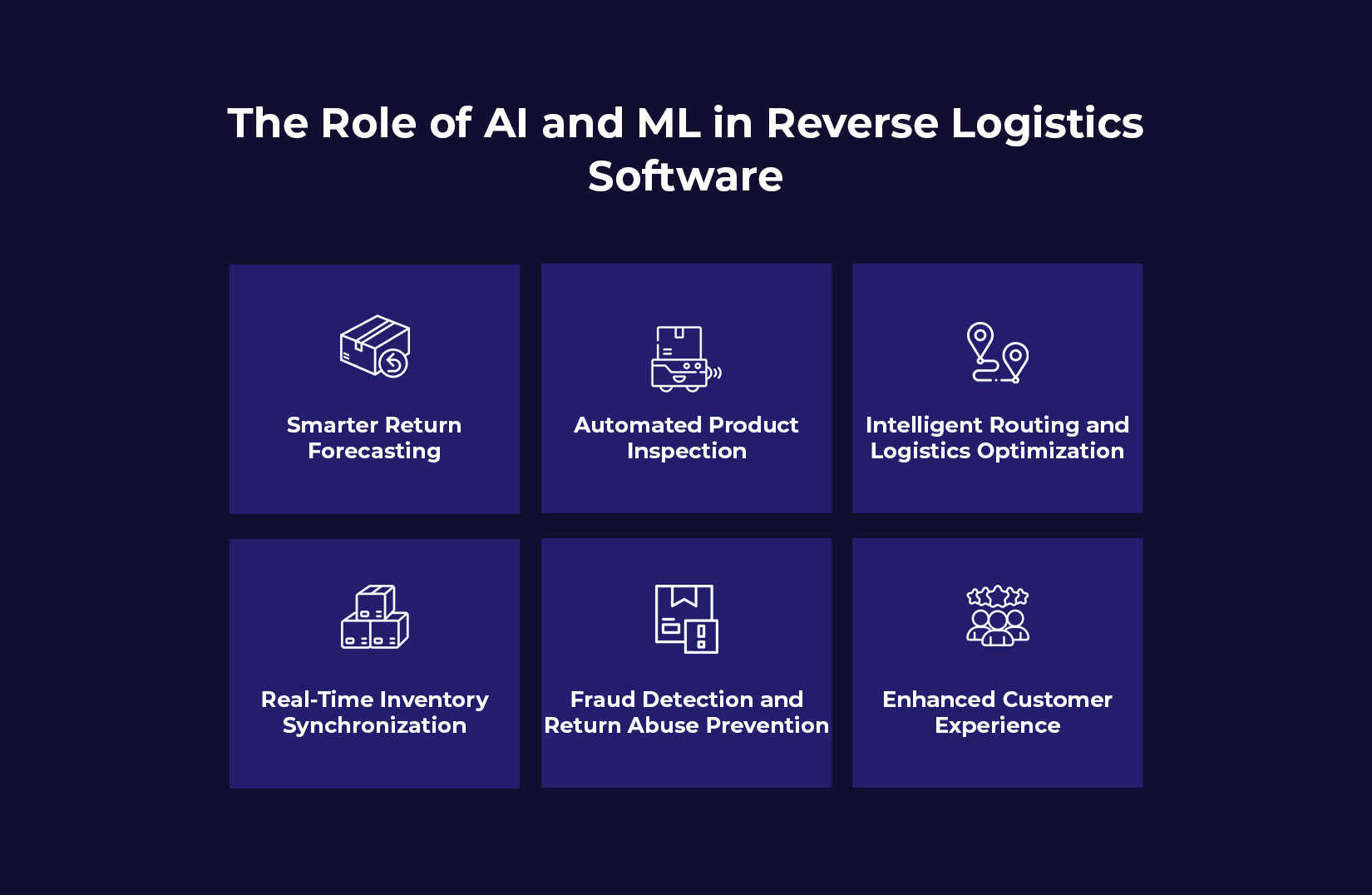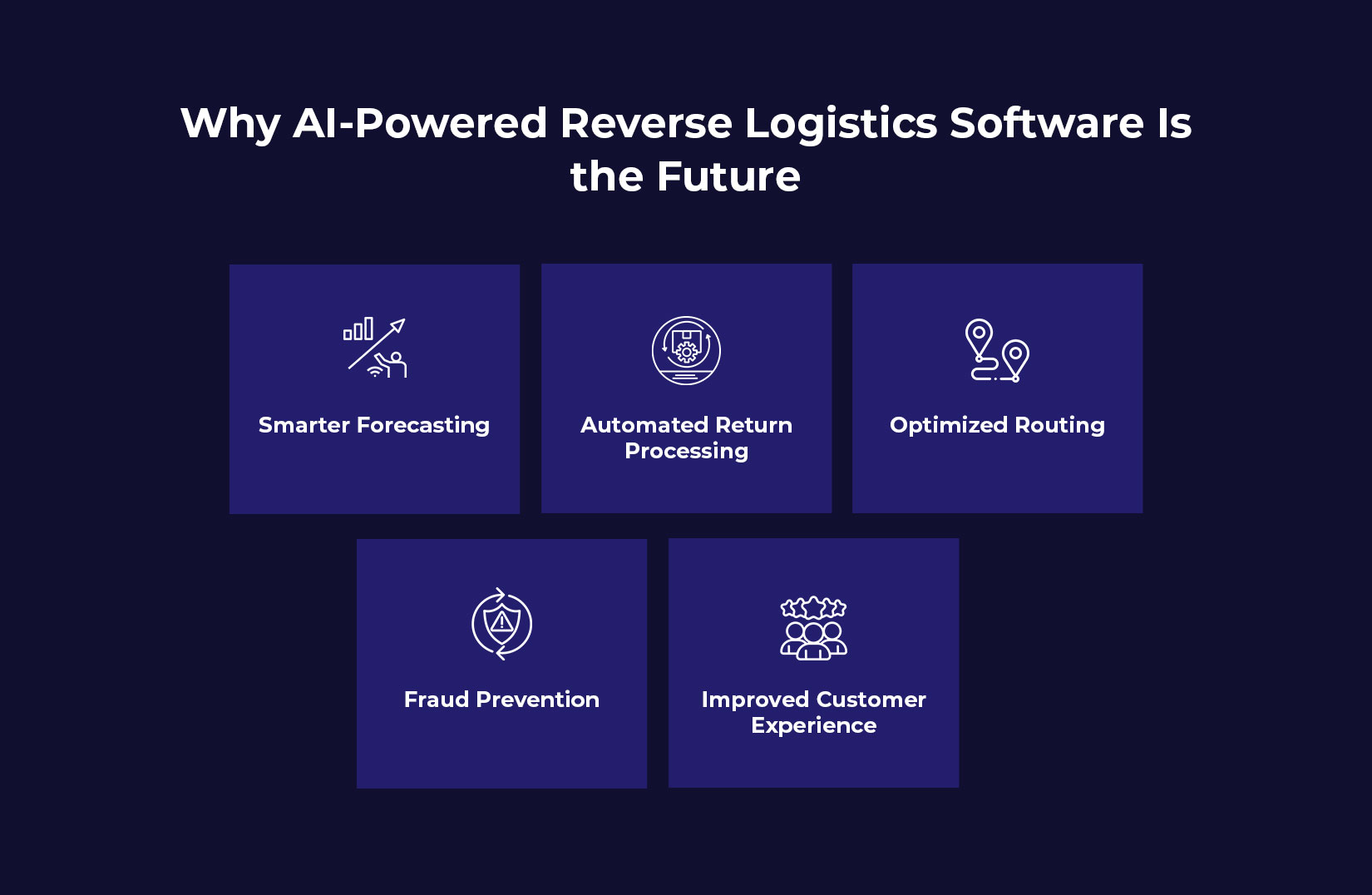
Revolutionizing Returns: AI and ML in Reverse Logistics Software
In today’s economy, managing returns efficiently is no longer optional- it’s indispensable. With global eCommerce returns expected to reach over $1.8 trillion by 2030, businesses must rethink how they handle the reverse flow of goods. This is where reverse logistics software steps in, and more importantly, how AI (artificial intelligence) and ML (machine learning) are transforming its performance.
By integrating these advanced technologies, companies are turning traditional reverse logistics from a cost center into a strategic advantage. In this blog, we’ll explore how AI-powered reverse logistics software is redefining efficiency, improving sustainability. Plus how its unlocking new opportunities across the supply chain.
What is Reverse Logistics?
All activities pertaining to the return of goods from the final consumer to the manufacturer or seller are included in reverse logistics. This covers recycling, disposal, repairs, returns, and renovations.
Unlike forward logistics, the reverse process is inherently more unforeseeable. Volumes fluctuate, product conditions vary, and return reasons differ. Manual or outdated systems struggle to manage these complexities efficiently.
That’s why modern businesses are turning to reverse logistics systems enhanced by artificial intelligence and machine learning.
The Role of AI and ML in Reverse Logistics Software

Artificial intelligence and machine learning introduce automation, intelligence, and adaptability into reverse logistics. These technologies help companies manage returns more effectively by analyzing vast amounts of data and identifying patterns. Thereby, making predictive decisions in real-time.
Here’s how reverse logistics software benefits from AI and ML integration:
1. Smarter Return Forecasting:
AI-powered forecasting tools analyze historical sales data, customer behavior, product categories, and seasonal trends to predict return volumes more accurately. According to McKinsey, AI can reduce forecasting errors by up to 50%. This leads to better planning for staffing, warehouse space, and transportation, resulting in lower operational costs.
2. Automated Product Inspection:
Manual inspection of returned goods is time-consuming and inconsistent. With AI, businesses can automate this process using image recognition and sensor data to assess product conditions. AI quickly determines whether items should be restocked, refurbished, or recycled. This reduces processing time and human error while improving the speed of resale or recovery.
3. Intelligent Routing and Logistics Optimization:
AI-powered reverse logistics software optimizes transportation routes based on live data, including traffic, fuel costs, carrier performance, and location clusters. Businesses using AI for logistics routing have reduced transportation costs by up to 30%. Efficient routing means faster returns, fewer emissions, and better resource utilization.
4. Real-Time Inventory Synchronization:
AI ensures returned products that are fit for resale are instantly updated in inventory systems. This real-time visibility helps restock products faster and improves inventory turnover rates. Integrated systems allow coordination between return centers, warehouses, and sales platforms. Helps reduce lost sales and enhances supply chain agility.
5. Fraud Detection and Return Abuse Prevention:
Return fraud is a growing concern which is costing retailers billions annually. AI and ML algorithms detect unusual return patterns, such as serial returners, switch fraud, or false damage claims. Businesses can automatically flag and prevent high-risk returns. AI-driven fraud detection can reduce return-related losses by 20% or more.
6. Enhanced Customer Experience:
AI supports real-time chatbots, return automation, and personalized communication. This simplifies the return process for customers and reduces pressure on support teams. Faster approvals, instant refunds, and proactive updates lead to improved customer satisfaction. Smart systems can suggest exchanges or alternatives to minimize full returns.
Why AI-Powered Reverse Logistics Software Is the Future

As product returns increase across industries, traditional systems fall short in handling the complexity and speed required. Here’s why AI-powered reverse logistics software is shaping the future:
1. Smarter Forecasting:
AI analyzes historical and real-time data to predict return volumes, helping businesses plan inventory, staffing, and logistics more accurately.
2. Automated Return Processing:
Machine learning automates inspection, sorting, and classification of returned goods, reducing errors and accelerating turnaround times.
3. Optimized Routing:
AI selects the most efficient routes for return pickups and redistributions, cutting transportation costs and lowering carbon emissions.
4. Fraud Prevention:
Advanced algorithms detect unusual return patterns, helping reduce losses from return abuse and enhancing policy enforcement.
5. Improved Customer Experience:
Real-time updates, instant approvals, and intelligent communication tools streamline the return journey, boosting customer satisfaction and loyalty.
Real-World Impact
A global consumer electronics brand integrated an AI-powered reverse logistics solution to streamline its high-volume returns process. Within just six months, the company saw significant operational improvements, including a 27% reduction in return processing time and a 38% increase in recovered product value. These efficiencies helped minimize delays and reduce associated labor costs.
In addition, the system enabled real-time inventory synchronization, allowing faster restocking of resaleable items. This led to improved inventory turnover and a 15% drop in customer complaints related to return delays and inconsistencies. Thus, ultimately boosting customer satisfaction and supply chain visibility.
Key Features to Look for in Reverse Logistics Solutions
When evaluating reverse logistics solutions, prioritize systems that include:
– Predictive return forecasting tools
– AI-based product condition assessment
– Dynamic route optimization
– Real-time integration with ERP and inventory systems
– Machine learning-driven fraud detection
– Scalable architecture for future growth
Selecting the best reverse logistics software ensures your operations are agile, efficient, and prepared for the challenges of modern commerce.
Conclusion
In a landscape where returns are inevitable, managing them intelligently makes all the difference. By embracing AI and machine learning, businesses can transform reverse logistics from a reactive function into a proactive strategy.
Reverse logistics software, when powered by AI, delivers measurable improvements across cost, speed, and sustainability. Whether you’re aiming to cut down return fraud, speed up processing, or improve customer satisfaction- AI is the key to unlocking superior performance.
If you’re ready to modernize your returns management, investing in AI & ML powered reverse logistics software is the smartest move forward. Thus, click on the red button below and book a demo with LogiNext today.
62







@LogiNext